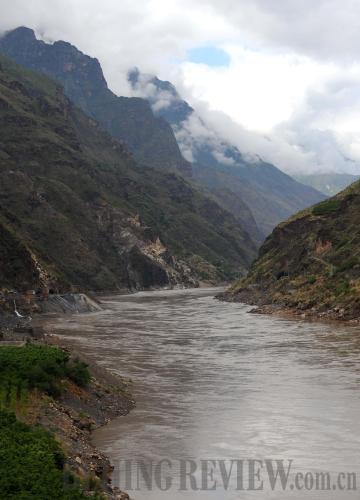|
 |
|
TO BE CHANGED: Twenty-five hydropower plants are planned along the Jinsha River, one of the major sources of the Yangtze River, actions that experts say will threaten the survival of local fish species (LIN YIGUANG) |
Liang Linkun is a veteran fisherman living in Changzhou City in east China's Jiangsu Province. Liang first started fishing in the Yangtze River in 1977 when he could catch more than 100 kg of saury, a type of small fish also referred to as "mackerel pike," in a single net. "But today, I can only net around 1 kg of saury at most," Liang sighed.
Statistics from fishery authorities of Jingjiang, a city adjacent to Changzhou, show that the total output of the saury there was 123 tons in 1998, 217.6 tons in 2001, but only around 10 tons in 2011.
With the steeply declining hauls, saury, which used to be a staple of the dinner table up and down the Yangtze, has become a luxury food that only the wealthiest of diners can afford. In April 2012, a fishing team caught a saury that weighed less than 0.33 kg in the lower stretch of the Yangtze, which later sold for 59,000 yuan ($9,625).
It is not only saury that is disappearing from the menu, the stocks of almost all fish species in the Yangtze have plummeted sharply over the past decades.
The population of the four major species of fish native to the Yangtze has shrunk from more than 30 billion in the 1950s to less than 100 million today. The number of different breeds of fish has similarly been reduced, from 143 to 17, according to a report released by the Yangtze River Fishery Resources Committee under the Ministry of Agriculture and the World Wide Fund for Nature (WWF) on August 15.
Besides the sharp decrease in the number of fish, some species, such as the finless porpoise, have already become extinct, said Zhao Yimin, Director of the committee.
Paradise lost
The Yangtze, which flows for a total length of 6,418 km eastward from its point of origin at the glaciers on the Qinghai-Tibet Plateau, is the longest river in China and the third longest in the world. Its total drainage area exceeds 1.8 million square km, accounting for 18.8 percent of China's total area.
According to statistics, the Yangtze once supported 1,100 species of wild aquatic animals, including more than 370 fish species— of which 142 were unique to the river and an estimated 20 or so of the species calling the Yangtze home have been categorized as endangered animals, including the Chinese paddlefish and the finless porpoise. Of the 35 species of freshwater fish farmed in China, the natural habitat of 26 of them is the Yangtze.
The recent report from the Yangtze River Fishery Resources Committee and the WWF is based on a 12-day scientific expedition in June. It was the first of its kind to study the upper reaches of the Yangtze's wetlands, aquatic diversity and water environment, according to the WWF.
The findings revealed that the river's aquatic ecosystem is on the verge of collapse due to human activity, such as the building of hydropower stations and over-fishing.
"The diversity of life in the Yangtze is receding, leading to the development of aquaculture in the river being unsustainable since it is supported by an increasingly fragile ecosystem," Zhao said.
"Species like ilish and puffer fish are hard to find, while paddlefish were last seen in the river in 2003," said Cao Wenxuan, a researcher with the Institute of Hydrobiology under the Chinese Academy of Sciences (CAS).
According to statistics from the Yangtze River Fishery Resources Committee, the fishing yield of the Yangtze dropped from 430,000 tons in 1954 to less than 100,000 tons in 2011.
Most fish caught in the Yangtze are only six months old and some are even less than two months old, leaving them with no chance of having any offspring, and thus no chance of replenishing the river's fishing stocks.
"If the rate of extinction continues to stay at the rate it is at now, freshwater fish are expected to disappear completely within 40 years," Cao warned. "Fish are a key part of the Yangtze's ecosystem. Without any fish, the Yangtze is just a pool of dead water."
Killing them softly
A 2006 investigative report by the Ministry of Environmental Protection disclosed that there were 20,000 chemical plants in China at the time, with nearly half of them located on the banks of the Yangtze.
| 